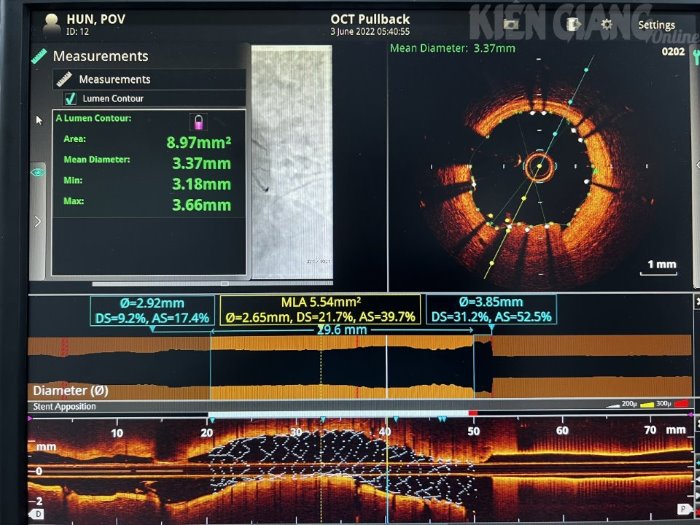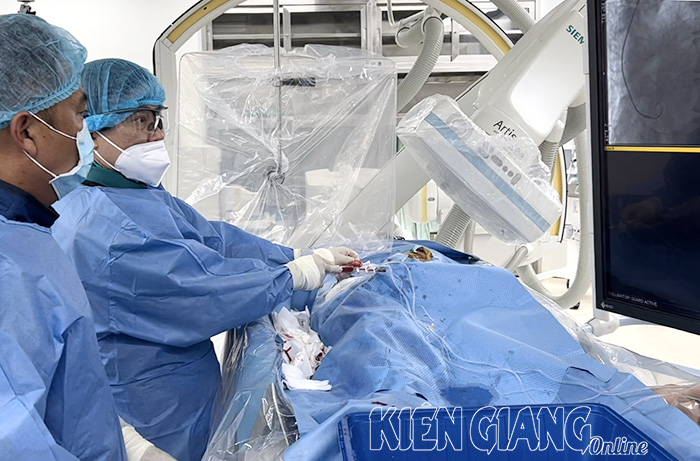Ischemic heart disease, also known as coronary artery disease, coronary atherosclerosis, coronary insufficiency, coronary failure... is common and mainly found in the elderly, people with high blood fat, obesity or heavy smoking, diabetes and family history of coronary artery disease. The disease has a high mortality rate. Kien Giang General Hospital has used percutaneous coronary intervention to save the lives of many patients.
According to Dr. Huynh Trung Cang - Head of the Department of Cardiology, Kien Giang General Hospital, when intervening and placing coronary stents for patients, doctors at the hospital rely on the technique of DSA angiography of blood vessels and coronary arteries with contrast.
Through the angiography image, the coronary artery with contrast, the doctors see this coronary artery lesion and rely on the simple image to intervene the blood vessel. Based on the contrast lumen through the DSA machine, the doctor estimates the coronary artery segment and measures the size of the lesion and chooses the size of the stent to place in the lesion with coronary artery stenosis of the patient.
Doctors at Kien Giang General Hospital apply coronary angiography imaging techniques in treating patients.
“This method is good but also has certain limitations, which is not knowing the morphology of the internal coronary artery such as calcified atherosclerotic tissue, lipid-containing atherosclerotic tissue, fibrous atherosclerotic tissue, the extent of the spread of the lesion and not knowing the side branch holes and the unpredictable complication rate of the procedure,” said Dr. Huynh Trung Cang.
To overcome this limitation, Kien Giang General Hospital applies OCT imaging technology. With this technique, doctors can assess whether the calcium plaque is severe or not, how lipid-containing the plaque is, fibrous tissue, and the side branch holes are. At the same time, they can measure whether the plaque is fragile or not, assess white or red blood clots, and assess each layer of blood vessels... If the above morphology is not accurately assessed and stents are placed, it will increase the risk of dissection after the procedure, causing stent occlusion, myocardial infarction, or restenosis.
Medical team of Kien Giang General Hospital performed coronary intervention for the patient.
Dr. Huynh Trung Cang said: “Kien Giang General Hospital has routinely deployed the technique of using a coronary angiography machine since the beginning of 2023. The hospital has performed over 35 cases, with a 100% success rate and achieved optimal stent placement results. After the intervention, patients with coronary artery disease had no complications, and the patient's clinical results improved well.”
As one of the patients who successfully underwent coronary intervention and was saved in time, Ms. Phan Thi Reo, residing in Binh Giang commune (Hon Dat) shared: “I had pain all over my chest, could not breathe and was taken to Kien Giang General Hospital for timely emergency care by my children and grandchildren. After the intervention and coronary stent placement, I could breathe and my health improved.”
Currently, Kien Giang General Hospital places coronary stents for many patients, an average of more than 1,200 cases per year, of which emergency cases account for nearly 50%. The number of patients coming to the hospital for cardiovascular examination is about 300-500 cases/day, most of whom have symptoms of ischemic heart disease.
Therefore, doctors recommend that people should have a healthy diet, not smoke, control blood sugar, blood lipids, blood pressure and exercise regularly to improve cardiovascular health. If a family member has a direct relative with coronary artery disease, they should have regular coronary artery disease screening.
Article and photos: VI AN
Source link



































































































Comment (0)